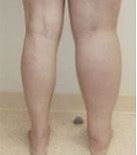Lymphedema
Adapted from Lymphedema (PDQ®)–Patient Version - National Cancer Institute
Jack Strickland, OMS III RVU
Lymphedema
The lymphatic system is a system of lymph vessels and lymph nodes that carries lymph fluid from soft tissues throughout the body. This lymph fluid is comprised of a watery mixture containing immune system byproducts. When the lymph system flow becomes dysfunctional, the fluid builds-up in the soft tissue of an extremity and is called lymphedema. This usually occurs in a single extremity but can be bilateral.
Signs and Symptoms:
Risk Factors: BUT……VERY OFTEN A CAUSE IS NOT SPECIFICALLY IDENTIFIED
An appropriate history and physical are usually sufficient for diagnosis. Unfortunately, there isn't a great imaging study or test to diagnose lymphedema yet. If referred to a vascular surgeon, appropriate vascular studies can be done to conclude that the vessels of the extremity are intact and functioning correctly but are not necessary.
Treatment Options:
Treatment for lymphedema is mainly compression through compression stockings or a compression device. This will decrease the pooling of lymph in the extremity, which will improve the swelling. Typically patients get a lymphatic pump, which is a sleeve that goes over the leg and pushes the fluid from the toes back to the center of the body. This is usually used for an hour or two, EVERY DAY. Compression stockings are worn from waking up in the morning and removed at bedtime to control the swelling. Exercise and massage therapy can also help push the lymph out of the extremity. MOST PATIENTS will improve with weight loss.
Go Back The lymphatic system is a system of lymph vessels and lymph nodes that carries lymph fluid from soft tissues throughout the body. This lymph fluid is comprised of a watery mixture containing immune system byproducts. When the lymph system flow becomes dysfunctional, the fluid builds-up in the soft tissue of an extremity and is called lymphedema. This usually occurs in a single extremity but can be bilateral.
Signs and Symptoms:
- Swelling of an arm or leg
- Feeling of fullness or heaviness in an arm or leg
- Tight feeling in the skin
- Itching of the skin of the extremity
- Non-pitting of the skin when pressed
- Loss of hair
Risk Factors: BUT……VERY OFTEN A CAUSE IS NOT SPECIFICALLY IDENTIFIED
- Prior Surgeries
- Trauma
- Hx of radiation
- Scar tissue
- Cancer
An appropriate history and physical are usually sufficient for diagnosis. Unfortunately, there isn't a great imaging study or test to diagnose lymphedema yet. If referred to a vascular surgeon, appropriate vascular studies can be done to conclude that the vessels of the extremity are intact and functioning correctly but are not necessary.
Treatment Options:
Treatment for lymphedema is mainly compression through compression stockings or a compression device. This will decrease the pooling of lymph in the extremity, which will improve the swelling. Typically patients get a lymphatic pump, which is a sleeve that goes over the leg and pushes the fluid from the toes back to the center of the body. This is usually used for an hour or two, EVERY DAY. Compression stockings are worn from waking up in the morning and removed at bedtime to control the swelling. Exercise and massage therapy can also help push the lymph out of the extremity. MOST PATIENTS will improve with weight loss.
